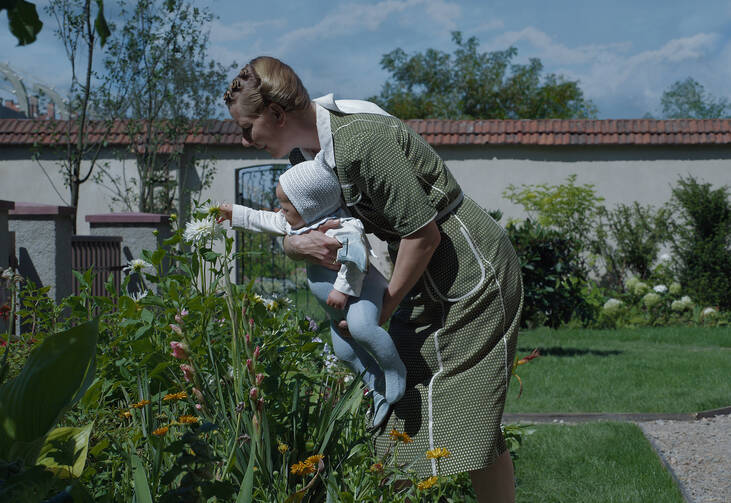Meeting with German engineers eager to exhibit their latest innovation, the Nazi commandant Rudolf Höss is imagining how to speed things up. He is occupied with the disposal—not of human beings—but of “pieces” at the concentration camp next door. One engineer suggests the construction of a new crematorium to quickly and cleanly exterminate the Jewish people caged at Auschwitz. The first step is to burn the bodies, then cool the ashes, and without any interruption, unload the pieces while the next group marked for death is shuffled forth.
Burn. Cool. Unload. Reload. Höss is pleased.
If what’s described above sounds terribly nauseating, if it is unbearably ghastly, if you wish not to read any further: That is the point. Even the commandant himself, the chief at Auschwitz before his execution in 1947, is almost sickened by his conscience at the end of “The Zone of Interest,” the director Jonathan Glazer’s nightmarish, surrealistic depiction of a Nazi family at peace with their sins. A challenging, formally rigorous work punctuated by inverted black-and-white images and fade transitions using the colors of the Nazi flag, “Zone” draws inspiration from the sardonic, agitated pen of the English novelist Martin Amis, who died in May.
“The Zone of Interest” is a surrealistic depiction of a Nazi family at peace with their sins.
Despite its marketing, Glazer’s film is not literally a “Holocaust drama” because, from a purely visual perspective, the Holocaust never appears. Its violence and misery emerge only in our minds while its horrors are heard from afar: muffled gunshots, screaming children, blaring music, roving trucks. A man is caught stealing an apple and then drowned by Nazi guards, but we don’t see this brutality. We hear it in the distance while onscreen, a young boy—one of the Höss children—plays with toys in his room. The boy crosses to his window after hearing the commotion. “Don’t do that again,” he whispers in German to the drowned man.
So what do we see if not the evils of Auschwitz? We see Rudolf Höss wander about his garden. We see his wife, Hedwig (a chilling Sandra Hüller), apply lipstick in her bedroom and model a fur coat in front of her mirror. We see pool parties and suppertime and Nazi Party society events with a live string section and a large ice sculpture carved in the shape of a swastika. We see that the Höss home is a safe place (for some), and rarely does that veneer of civility slip to reveal the sinister intentions underneath. “I could have my husband spread your ashes across the fields of Babice,” says Hedwig quietly to her Jewish house servant Aniela.
And above all, we see what the 20th-century philosopher Hannah Arendt, after covering the Jerusalem trial of Holocaust architect Adolf Eichmann in the early 1960s, calls “the banality of evil”—the understanding that Höss (like Eichmann) is an intensely unremarkable man orchestrating historic evils.
Despite its marketing, Glazer’s film is not literally a “Holocaust drama” because, from a purely visual perspective, the Holocaust never appears.
Film critics have remarked on the banality of evil in “Zone,” but few have commented on the film as a work of anti-representation. Here is a film where depiction is obscured and obscene, where the audience is first met with nothing but a black screen and Mica Levi’s dissonant, borborygmic score. For the opening several minutes, we are submerged in darkness and left with our wandering thoughts. Even after we meet the Höss family, Glazer still does not indulge in some shocking, headline-making illustration of Nazi atrocities.
In a radical act of artistic courage, “Zone” resists the Pasolinian urge to render the grotesque in the most explicit manner possible, just to make a point. I’m referring specifically to Pier Paolo Pasolini’s 1975 film “Salò, or the 120 Days of Sodom,” an unrelenting provocation in which 18 teenagers are tortured, raped and eventually murdered by their fascist captors in World War II-era Italy. “Salò” assaults the viewer with a front-row seat to unprintable behavior that earned the picture its notorious reputation and saw it banned in several countries.
“Zone” is even more bracing and thought-provoking than “Salò,” and Glazer achieves this by refusing to show the film’s real subject matter because it is not a commodity to be consumed. The evils of the Holocaust must be rejected, even by the camera itself. Glazer’s non-depiction of concentration camps, similar to “Oppenheimer” director Christopher Nolan’s non-depiction of the on-the-ground devastation produced by the nuclear bombings of Hiroshima and Nagaski, is sure to elicit disagreement and debate. But Glazer does not shy away from presenting the cool, calculating amorality of the Nazis. He confronts us with the bureaucracy of evil, a series of meetings and polite discussions that render the unthinkable as logical, pragmatic or even genteel.
What evil is happening right now, right under our nose, that we fail to see or choose to ignore?
In a meeting with the commandants of various concentration camps, one Nazi chief is praised for “meeting his labor targets.” They discuss Hitler’s approved deportation (and later execution) of more than 400,000 Hungarian Jews. A proud and grateful Höss is appointed to lead this operation. Calmly, the commandants then list what is needed: air defense, transportation, timing, et cetera. Business as usual.
During a phone call with his wife, Höss excitedly describes how Nazi leadership is naming the Hungarian operation after him. Finally, he has something to call his own. He hangs up the phone, walks down a dimly lit hallway and descends a staircase before stopping to retch. He moves ahead, dry heaves and then, in the film’s most unexpected scene, has a vision of the future: a modern-day cleaning crew at the Auschwitz-Birkenau State Museum. Höss gazes at piles of shoes, dormant crematoria and empty gas chambers. A pause. He dons his cap and walks away.
I’ll propose another theory about the film: We do not see the mass murder of more than six million Jews because we are still blind. In 2014, an Anti-Defamation League survey of more than 53,000 people from some 100 countries found that only 54 percent of respondents knew about the Holocaust. A 2020 survey of millennials and Gen Zers found that 11 percent of respondents blame the Jewish people for the Holocaust. And in late October, the Anti-Defamation League reported a 388 percent increase in “antisemitic incidents” in the United States during the period from Oct. 7 through 23, in comparison with the same period last year.
As Höss walks away and the theater lights come up, we cannot avoid responsibility for the horrors of the past. What evil is happening right now, right under our nose, that we fail to see or choose to ignore? For the Höss family, the answer was next door.
Correction, Feb. 5: An earlier version of this article named the Jewish house servant whom Hedwig addresses as Aniela. In the scene referenced, Hedwig is speaking to her other servant Aniela.








